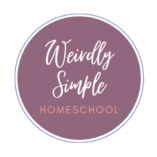What is the Loop Book?
Put your homeschool routine on autopilot!
*This post contains affiliate links, which means I receive a small commission, at no extra cost to you, if you make a purchase using these links. I only share links to items that we use and love! Please see my disclosure for more details.
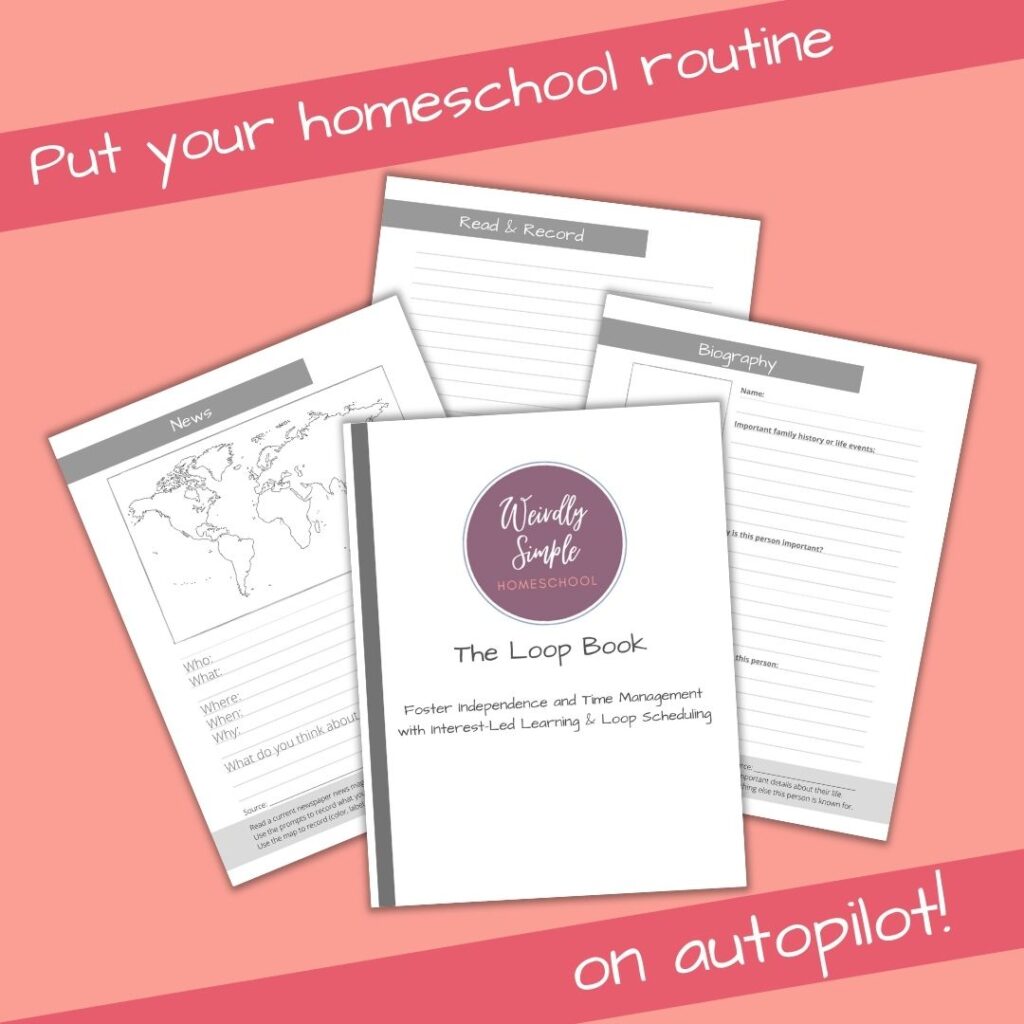
The Loop Book is a homeschooling tool I designed to simplify our learning routines, and to encourage independent learning in our home! It’s an easy one-book combination of the things we love about notebooking pages, fun-schooling journals, workboxes, and loop scheduling.
- Notebooking Pages: These are usually topic-specific blank templates for students to fill in information by writing and drawing. There are thousands upon thousands of notebooking pages available online–which is wonderful! But also overwhelming.
I didn’t want to spend hours searching for new notebooking pages for whatever we were studying every time I wanted my children to be able to use this excellent way of recording what they’ve learned. I wanted, instead, to have streamlined, universally-usable notebooking-style pages that we could use again and again, no matter what topic we were studying! - Fun-Schooling: We fell in love with the idea of Fun-Schooling as soon as we discovered Thinking Tree’s beautiful journals! The drive behind fun-schooling is student-directed learning. Kids study what they love, and use the journals to record what they’ve learned (much like notebooking pages).
My 9 year old daughter uses her Fun-Schooling journals regularly because she loves the feel of the cover, the beautiful artwork, and the variety of the pages. This particular daughter is an extremely creative type, and these journals are perfect for that learning personality!
But we also found that we all, especially my boys, longed for a more consistent loop of page types. And it was also difficult for my kids to find journals for which they loved 100% of the pages, so we end up skipping or repurposing many of the journal pages (which is fine! but not very efficient). We still love fun-schooling journals, but we needed another more consistent and adaptable way to record our learning. - Workboxes: When I first started on this homeschooling journey so many years ago, I thought workboxes were the COOLEST THING EVER. The basic idea is to get a stack of shallow drawers and load them individually with the curriculum and supplies your student needs for that day. You can even add a drawer with a snack break or other type of break! It functions kind of a like a loop: your student simply starts with the top drawer/box and works their way down until they are finished. Brilliant!
But also, it involved a lot of stuffing of boxes every day, planning, and actual curriculums and things to stick in the boxes (I am notoriously not great at plunking my way through a structured curriculum…ahem, hence this loop book thing I’ve created). So while I love how workboxes foster independence, the actual daily planning and stuffing of the boxes was a hindrance to the free spirit personalities (especially mine) in our home. - Loop Scheduling: This brings us to loop scheduling! I super duper love loop scheduling. It basically saved my life. Okay, maybe that’s a bit dramatic. But I spent many years of this homeschool journey wondering why I couldn’t force myself to plod through open-and-go curriculums, or map out daily schedules, or even just fit science in regularly (oops).
Putting all my Great Big Ideas on a list and looping through them made me feel AWESOME because it meant I was finally “fitting in” All The Things! I was free from the burden of schedules and deadlines. The arbitrary constructs of grade levels and school years and even, sometimes, beginnings & ends in general–ALL were banished with the loop. We just kept going forward through our learning adventures!
However–I needed a teeny bit of structure there with my loops. They were getting out of control! And maybe a tad extra long. 😉 So I looped back to what we loved about workboxes and fun-schooling and notebooking and–tada! The Loop Book was born.
How does the Loop Book work?
Put your homeschool routine on autopilot!

You’ll choose from a wide variety of high-quality, versatile notebooking-style pages to create a custom Loop Book. The Loop Book serves as both prompts for learning, and also a way for your student to record all the wonderful information they learn throughout the year! It’s set up like a loop, so that those pesky subjects that threaten to get left behind no longer end up neglected!
We set up our Loop Book in one-week sections, but you can customize yours however you like! My 11yo actually has two different weeks of Loop Book pages that he alternates, to keep some variety!
My kids like to have the expectation of a set amount of pages to complete over the course of one week. There is no requirement for how much they should work in their Loop Book on any given day, but having the goal to reach at the end of the week gives them ample experience with planning ahead and organizing their time. This is an excellent and vital life skill!
Loop Book Set-Up in 3 Simple Steps

Step 1
Make a list of subjects or tasks you would like your child to do weekly (or any timeframe of your choosing).
My 11 year old son’s list looks like this:
- Reading or Spelling/Vocabulary
- Grammar
- Social Studies
- Creative Time (art or Minecraft design)
- Geography
- Current Events
- Science
- Science Experiment
- History
- LEGO design (he aspires to work for LEGO someday)
- Creative Writing
- Nature Study
Step 2
Choose the best page for each subject/task. There are 46 pages to choose from! It’s helpful to have your child choose with you, and to choose pages that fit your child’s learning style.
For example, my son likes designing comics, so for History, every other week he designs a comic using a Design a Comic page about something we’ve learned that week. On the opposite weeks, he reads a short biography of his choosing and completes a Biography page.
Step 3
Set it and forget it! 😉 Print the chosen pages, assemble them, and bind them any way you choose. We use a comb binding machine here, but you could just stick them in a 3-ring binder, loose in a folder, or staple the corner. Then you’re all set!
What do the pages look like?
Loop Book pages are designed with both efficiency and aesthetics in mind. All pages are black & white, but I’ve used dark shades of grey rather than true black. This is easier on the eyes, and it also uses less printer ink! 😉 The Loop Book is also created with clean lines and close attention to detail. I worked hard to make the pages consistent, aligned, and free from distractions and errors (if you do ever find an error in my products or on my blog, please tell me! I will fix it promptly!).
The bottom of each Loop Book page contains brief instructions to prompt your student and offer different ideas for completing the page. There is also a spot on each page to record the source of information.
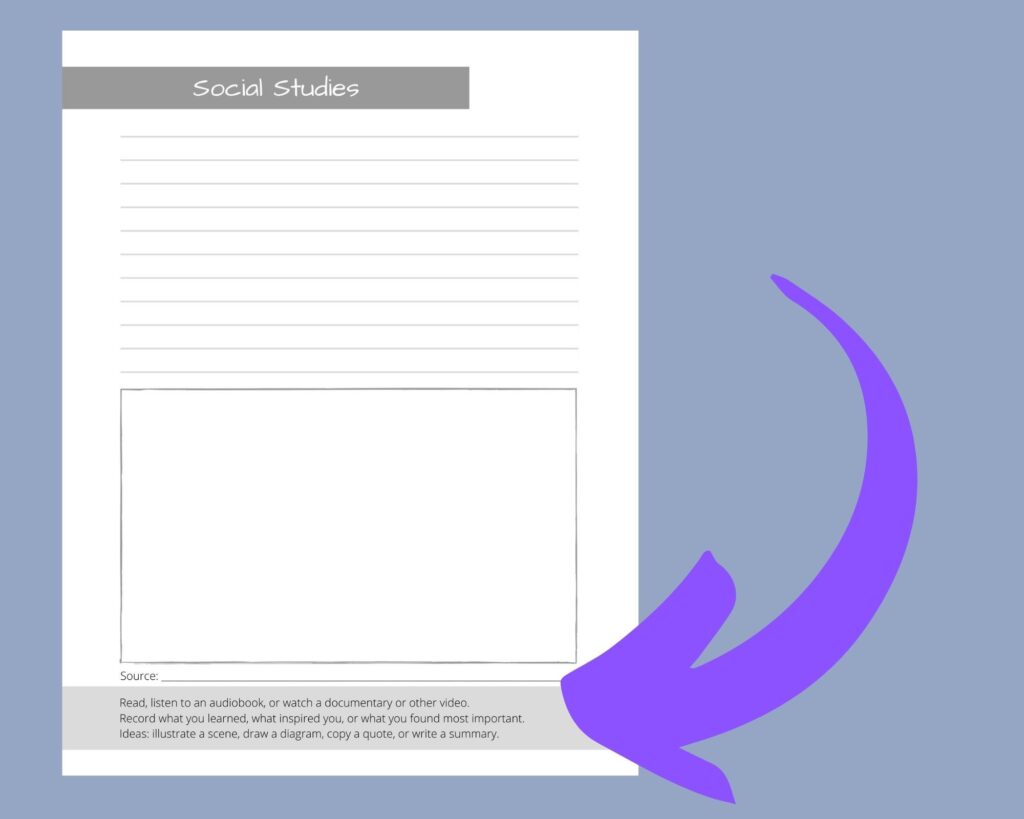
Each page also has various amounts of room for writing and/or drawing, so you can choose the pages that best fit your child’s skill level.
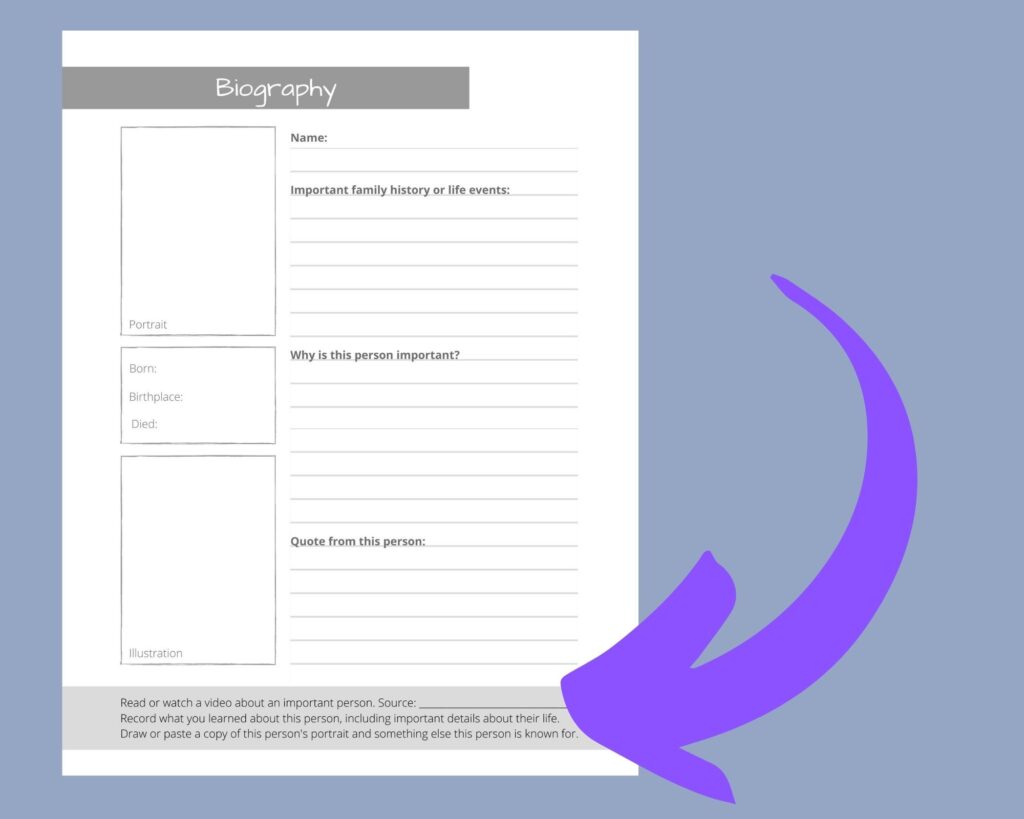
There are various layouts for similar pages provided, some more guided than others, so that you can choose how much guidance your child needs.
Resources
Expectations for source material are entirely up to you! I’ve designed these pages to be flexible enough to use for anything from structured parent-led curriculum to an eclectic assortment of student-chosen material. You can work with your child in the beginning to set expectations and goals for each page. Soon they will be independent with their Loop Book!
We use the library heavily, and we have also worked to create a large home library of both fiction and nonfiction titles for our kids to choose from. But you can utilize any resources available to you. Library books are an obvious choice, but some kids learn better by watching videos, listening to audiobooks, or doing hands-on activities. Loop Book pages are great for recording observations, information, and ideas from any resource or activity!
We use a mix of resources in our home. Here are some of our favorites:
- Khan Academy has free online lessons for just about anything!
- Geography Now! on YouTube is a fast-paced, entertaining channel with videos about every country.
- The Week Junior is an excellent news magazine geared toward kids ages 8-14.
- Science YouTubers: Mark Rober, Physics Girl, Smarter Every Day, Crash Course Kids.
- Curiosity Stream is an inexpensive and high quality documentary streaming service! Tons to choose from across multiple subjects.
- Story of the World audiobook cds offer a great overview of history from ancient to modern times, geared toward elementary into middle school.
- Soul Sparklettes Art offers both free and paid guided art projects. They are very easy to use and easy to adapt!
The Bottom Line
We’ve had such success using this method in our homeschool, that I wanted to share it with other families who could benefit, as well! My oldest, especially, has thrived on the freedom and independence he has gained using the Loop Book to take control of his learning. As a bonus, it’s extremely easy for me to prepare! As long as I can keep up with how fast he plows through books and other resources, our weeks go quite smoothly! 😉
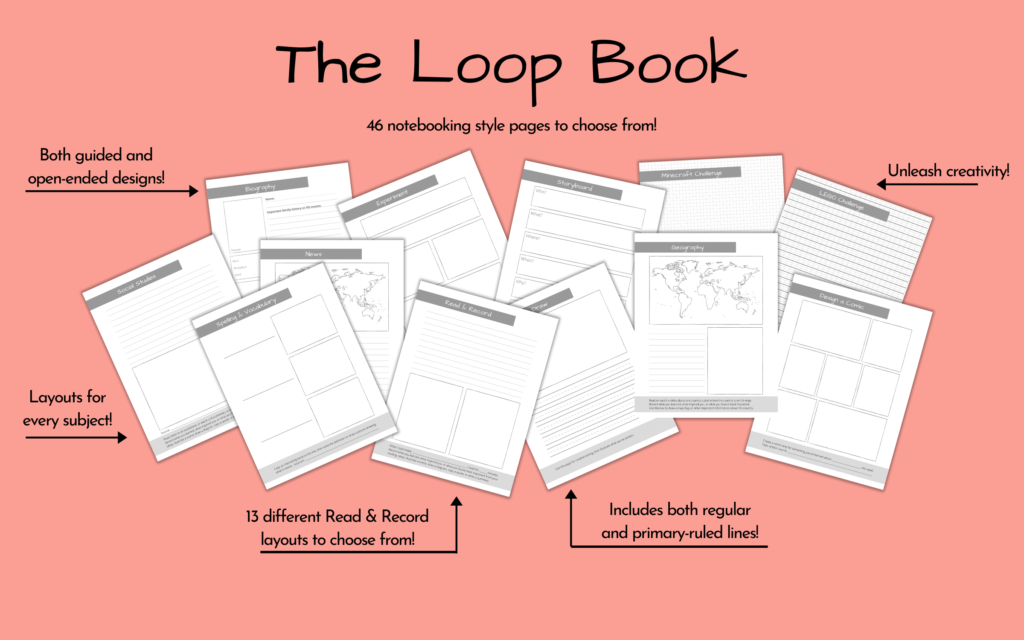
With 46 high-quality and extremely versatile pages to choose from, you would normally pay anywhere from fifty to hundreds of dollars for notebooking page downloads, or spend hundreds of hours scouring the Internet for less-than-ideal free notebooking pages to piece together.
But with The Loop Book, you get EVERYTHING you need to start fostering independence and time management skills in your child today, for just a fraction of the price! I plan to keep the Loop Book at an affordable price forever, but for a limited time, you can get the entire Loop Book now for ONLY $11!
